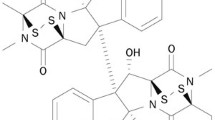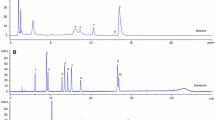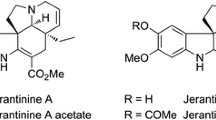Abstract
Genistein, due to its recognized chemopreventive and antitumour potential, is a molecule of interest as a lead compound in drug design. Recently, we found that the novel genistein derivative, [7-O-(2,3,4,6-tetra-O-acetyl-β-D-galactopyranosyl)-(1 → 4)-(6-O-acetyl-hex-2-ene-α-D-erythro pyranosyl)genistein, named G21, induced aberrations in mitotic spindle formation. In the presented study, we investigated the properties of G21 relevant to its genotoxic activity. The inhibition of topoisomerase IIα activity was evaluated in decatenation assay and immunoband depletion assay, the covalent DNA–topoisomerase IIα complexes and histone ɣH2AX were detected immunofluorescently. Genotoxic effects of the tested compounds were assessed in micronucleation assay. The presence of centromeres in the micronuclei and the multiplication of centrosomes were evaluated in fluorescence immunolabelled specimens. The inhibition of tubulin polymerization was measured spectrophotometrically. We found that both tested drugs were able to inhibit topoisomerase II activity; however, G21, in contrast to genistein, blocked this enzyme at the concentration far exceeding cytotoxic IC50. We also found that both compounds caused micronucleation in DU 145 prostate cancer cells, but in contrast to genistein, G21 exhibited aneugenic activity, manifested by the presence of centromeres in micronuclei formed in cells treated with the drug. Aneugenic properties of G21 resulted from the inhibition of tubulin polymerization and centrosome disruption, not observed in the presence of genistein. The study supports and extends our previous observations that the mechanisms of cytotoxicity of genistein and its new glycosidic derivative—G21 are significantly different.







Similar content being viewed by others
References
Ahmed AA, Goldsmith J, Fokt I, Le XF, Krzysko KA, Lesyng B, Bast Jr RC, Priebe W. A genistein derivative, ITB-301, induces microtubule depolymerization and mitotic arrest in multidrug-resistant ovarian cancer. Cancer Chemother Pharmacol. 2011;68:1033–44.
Bacher G, Beckers T, Emig P, Klenner T, Kutscher B. New small-molecule tubulin inhibitors. Pure Appl Chem. 2001;73:1459–64.
Banerjee S, Li Y, Wang Z, Sarkar FH. Multi-targeted therapy of cancer by genistein. Cancer Lett. 2008;269:226–42.
van Brussel JP, van Steenbrugge GJ, Romijn JC, Schroeder FH, Mickisch GHJ. Chemosensitivity of prostate cancer cell lines and expression of multidrug resistance-related proteins. Eur J Cancer. 1999;35:664–71.
Büchler P, Gukovskaya AS, Mouria M, Büchler MC, Büchler MW, Friess H, Pandol SJ, Reber HA, Hines OJ. Prevention of metastatic pancreatic cancer growth in vivo by induction of apoptosis with genistein, a naturally occurring isoflavonoid. Pancreas. 2003;26:264–73.
Chen JG, Horvitz SB. Differential mitotic responses to microtubule-stabilizing and destabilizing drugs. Cancer Res. 2002;62:1935–8.
Constantinou A, Mehta R, Runyan C, Rao K, Vaughan A, Moon R. Flavonoids as DNA topoisomerase antagonists and poisons: structure–activity relationships. J Nat Prod. 1995;58:217–25.
Davis DA, Sarkar SH, Hussain M, Li Y, Sarkar FH. Increased therapeutic potential of an experimental anti-mitotic inhibitor SB715992 by genistein in PC-3 human prostate cancer cell line. BMC Cancer. 2006;6:22.
Deming PB, Cistulli CA, Zhao H, Graves PR, Piwnica-Worms H, Paules RS, Downes SC, Kaufmann WK. The human decatenation checkpoint. PNAS. 2001;98:12044–9.
di Virgilio AL, Iwami K, Wätjen W, Kahl R, Degen GH. Genotoxicity of the isoflavones genistein, daidzein and equol in V79 cells. Toxicol Lett. 2004;151:151–62.
Dixon RA, Ferreira D. Genistein. Phytochemistry. 2002;60:205–11.
Efthimiou M, Andrianopoulos C, Stephanou G, Demopoulos NA. Nikolaropoulos SS Aneugenic potential of the nitrogen mustard analogues melphalan, chlorambucil and p-N, N-bis(chloroethyl)aminophenylacetic acid in a cell cultures in vitro. Mutat Res. 2007;617:125–37.
Fang MZ, Chen D, Sun Y, Jin Z, Christman JK, Yang CS. Reversal of hypermethylation and reactivation of p16INK4a, RARbeta, and MGMT genes by genistein and other isoflavones from soy. Clin Cancer Res. 2005;11:7033–41.
Fenech M. Cytokinesis-block micronucleus cytome assay. Nat Protoc. 2007;2:1084–104.
Fenech M. The in vitro micronucleus technique. Mutat Res. 2000;455:81–95.
Güerci A, Seoane A, Dulout FN. Aneugenic effects of some metal compounds assessed by chromosome counting in MRC-5 human cells. Mutat Res. 2000;469:35–40.
Guo Y, Wang S, Hoot DR, Clinton SK. Suppression of VEGF-mediated autocrine and paracrine interactions between prostate cancer cells and vascular endothelial cells by soy isoflavones. J Nutr Biochem. 2007;18:408–17.
Hegarat LL, Orsiere T, Botta A, Fessard V. Okadaic acid: chromosomal non-disjunction analysis in human lymphocytes and study of aneugenic pathway in CHO-K1 cells. Mutat Res. 2005;578:53–63.
Iarmarcovai G, Botta A, Orsière T. Number of centromeric signals in micronuclei and mechanisms of aneuploidy. Toxicol Lett. 2006;166:1–10.
Johnson GE, Jenkins GJ, Thomas AD, Doak SH. Vinblastine and diethylstilboestrol tested in the in vitro mammalian cell micronucleus test (MNvit) at Swansea University UK in support of OECD draft Test Guideline 487. Mutat Res. 2010;702:189–92.
Lania-Pietrzak B, Michalak K, Hendrich AB, Mosiądz D, Grynkiewicz G, Motohashi N, Shirataki Y. Modulation of MRP1 protein transport by plant, and synthetically modified flavonoids. Life Sci. 2005;77:1879–91.
Luo K, Yuan J, Chen J, Lou Z. Topoisomerase IIα controls the decatenation checkpoint. Nat Cell Biol. 2009;11:204–10.
Martin-Cordero C, Lopez-Lazaro M, Pinero J, Ortiz T, Ayuso MJ. Glucosylated isoflavones as DNA topoisomerase poisons. J Enzyme Inhib. 2000;15:455–60.
Metzler M, Pfeiffer E. Effects of estrogens on microtubule polymerization in vitro: correlation with estrogenicity. Environ Health Perspect. 1995;103:21–2.
Middleton E, Kandaswami C, Theoharides TC. The effects of plant flavonoids on mammalian cells: implications for inflammation, heart disease, and cancer. Pharmacol Rev. 2000;52:673–751.
Moisoi N, Erent M, Whyte S, Martin S, Bayley PM. Calmodulin-containing substructures of the centrosomal matrix released by microtubule perturbation. J Cell Sci. 2002;115:2367–79.
Mukherjee S, Acharya RB, Bhattacharyya B, Chakrabarti G. Genistein arrests cell cycle progression of A549 cells at the G2/M phase and depolymerizes interphase microtubules through binding to a unique site of tubulin. Biochemistry. 2010;49:1702–12.
Nakada S, Katsuki Y, Imoto I, Jokohama T, Nagasawa M, Inazawa J, Mizutani S. Early G2/M checkpoint failure as a molecular mechanism underlying etoposide-induced chromosomal aberrations. J Clin Invest. 2006;116:80–9.
Nguyen H, Zhang S, Morris ME. Effect of flavonoids on MRP1-mediated transport in Panc-1 cells. J Pharm Sci. 2003;92:250–7.
Norppa H, Falck G. What do human micronuclei contain. Mutagenesis. 2003;18:221–33.
Pinski J, Wang Q, Quek ML, Cole A, Cooc JK, Danenberg K, Danenberg PV. Genistein-induced neuroendocrine differentiation of prostate cancer cells. Prostate. 2006;66:1136–43.
Polkowski K, Popiołkiewicz J, Krzeczyński P, Ramza J, Pucko W, Zegrocka-Stendel O, Boryski J, Skierski JS, Mazurek AP, Grynkiewicz G. Cytostatic and cytotoxic activity of synthetic genistein glycosides against human cancer cell lines. Cancer Lett. 2004;203:59–69.
Raffoul J, Banerjee S, Che M, Knoll ZE, Doerge DR, Abrams J, Kucuk O, Sarkar FH, Hillman GG. Soy isoflavones enhance radiotherapy in a metastatic prostate cancer model. Int J Cancer. 2007;120:2491–8.
Rusin A, Gogler A, Głowala-Kosińska M, Bochenek D, Gruca A, Grynkiewicz G, Zawisza J, Szeja W, Krawczyk Z. Unsaturated genistein disaccharide glycoside as a novel agent affecting microtubules. Bioorg Med Chem Lett. 2009;19:4939–43.
Rusin A, Krawczyk Z, Grynkiewicz G, Gogler A, Zawisza-Puchałka J, Szeja W. Synthetic derivatives of genistein, their properties and possible applications. Acta Biochim Pol. 2010;57:23–34.
Rusin A, Krawczyk Z. Genistein derivativatization. From a dietary suplement to a pharmaceutical agent. In: El-Shemy H, editor. Soybean/Book 4. Rijeka: In-Tech; 2011. p. 253–82.
Rusin A, Zawisza Puchalka J, Kujawa K, Gogler-Piglowska A, Wietrzyk J, Świtalska M, Głowala-Kosińska M, Gruca A, Szeja W, Krawczyk Z, Grynkiewicz G. Synthetic conjugates of genistein affecting proliferation and mitosis of cancer cells. Bioorg Med Chem. 2011;19:295–305.
Thompson SL. Compton DA Examining the link between chromosomal instability and aneuploidy in human cells. J Cell Biol. 2008;180:665–72.
van Rijn J, van den Berg J. Flavonoids as enhancers of X-ray-induced cell damage in hepatoma cells. Clin Cancer Res. 1997;3:1775–9.
Vantyghem SA, Wilson SM, Postenka CO, Al-Katib W, Tuck AB, Chambers AF. Dietary genistein reduces metastasis in a postsurgical orthotopic breast cancer model. Cancer Res. 2005;65:3396–403.
Wang Y, Raffoul JJ, Che M, Doerge DR, Joiner MC, Kucuk O, Sarkar FH, Hillman GG. Prostate cancer treatment is enhanced by genistein in vitro and in vivo in a syngeneic orthotopic tumor model. Radiat Res. 2006;166:73–80.
Webb RJ, Judah JD, Lo LC, Thomas GMH. Constitutive secretion of serum albumin requires reversible protein tyrosine phosphorylation events in trans-Golgi. Am J Physiol Cell Physiol. 2005;289:C748–56.
Wendell KL, Wilson L, Jordan MA. Mitotic block in HeLa cells by vinblastine: ultrastructural changes in kinetochore-microtubule attachment and in centrosomes. J Cell Sci. 1993;104:261–74.
Willmore E, Frank AJ, Padget K, Tilby MJ, Austin CA. Etoposide targets topoisomerase II alpha and II beta in leukemic cells: isoform-specific cleavable complexes visualised and quantified in-situ by a novel immunofluorescence technique. Mol Pharmacol. 1998;54:78–85.
Yan SX, Ejima Y, Sasaki R, Zheng SS, Demizu Y, Soejima T, Sugimura K. Combination of genistein with ionizing radiation on androgen-independent prostate cancer cells. Asian J Androl. 2004;6:285–90.
Yashar CM, Spanos WJ, Taylor DD, Gercel-Taylor C. Potentiation of the radiation effect with genistein in cervical cancer cells. Gynecol Oncol. 2005;99:199–205.
Zhang LN, Xiao ZP, Ding H, Ge HM, Xu C, Zhu HL, Tan RX. Synthesis and cytotoxic evaluation of novel 7-O-modified genistein derivatives. Chem Biodivers. 2007;4:248–55.
Acknowledgements
This work was supported by Grant of Foundation for Supporting of Polish Pharmacy and Medicine 06/FB/2004 and PBZ MNiI-1/1/2005. AG-P was supported by the Regional Graduate Studies Fund within the framework of the Integrated Regional Operational Programme financed by the European Social Fund.
Conflict of interest
The authors declare no conflict of interest.
Author information
Authors and Affiliations
Corresponding author
Rights and permissions
About this article
Cite this article
Gogler-Pigłowska, A., Rusin, A., Bochenek, D. et al. Aneugenic effects of the genistein glycosidic derivative substituted at C7 with the unsaturated disaccharide. Cell Biol Toxicol 28, 331–342 (2012). https://doi.org/10.1007/s10565-012-9227-9
Received:
Accepted:
Published:
Issue Date:
DOI: https://doi.org/10.1007/s10565-012-9227-9




